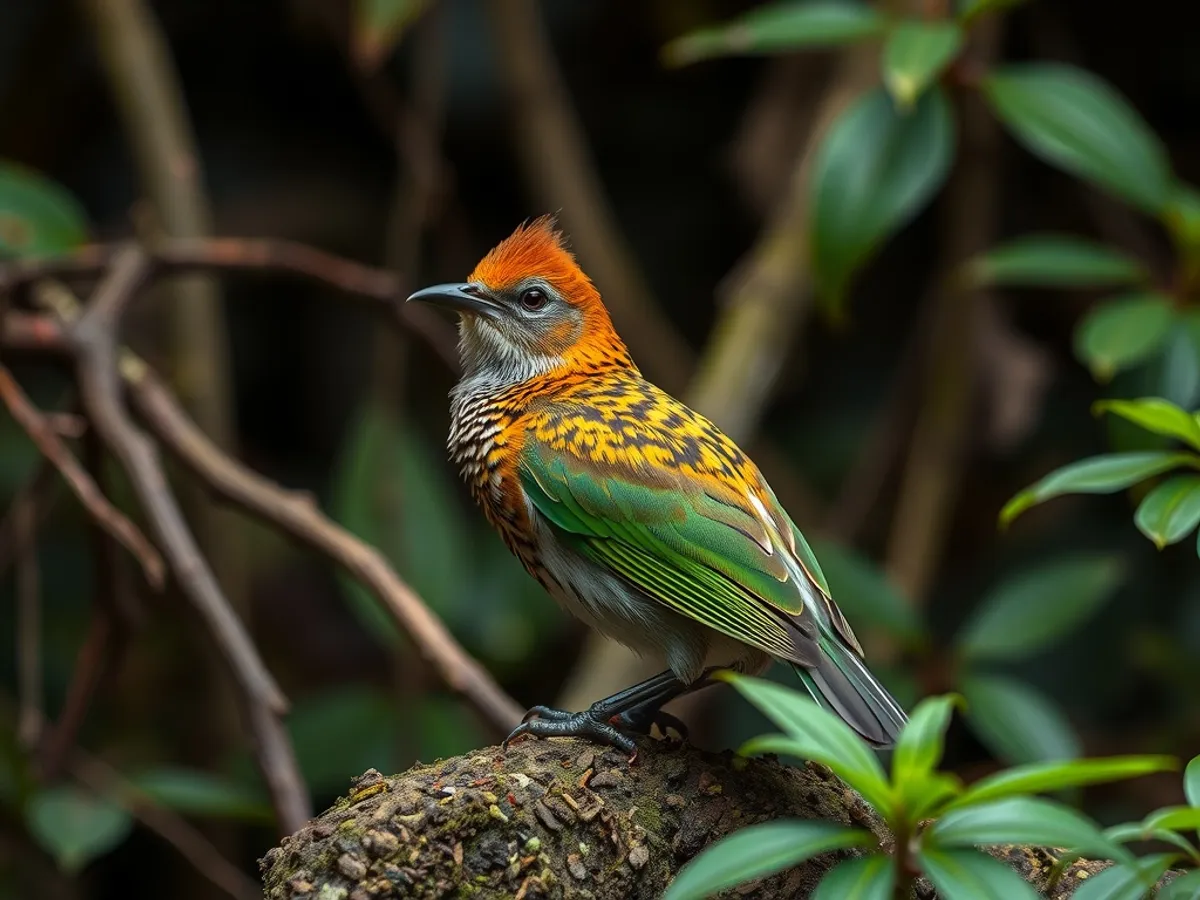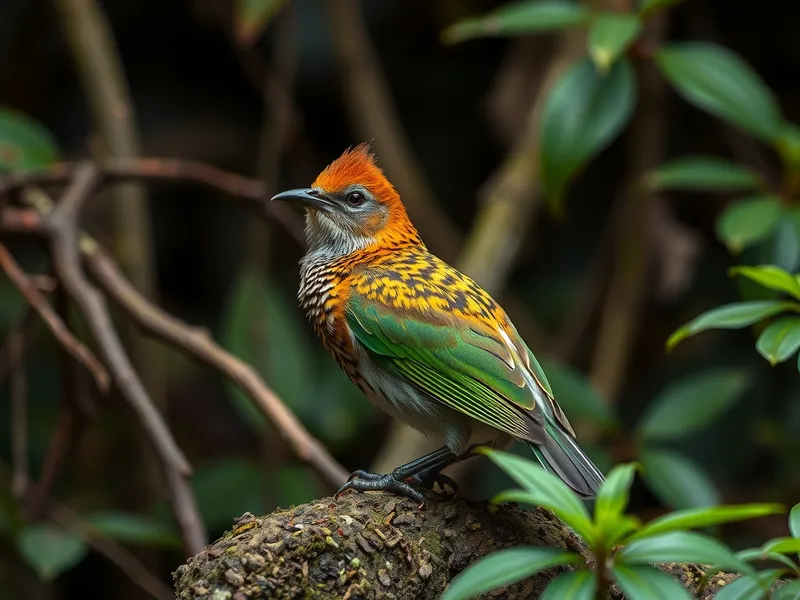
Andean Cock-of-the-rock
Rupicola peruvianus

Meet the Andean Cock-of-the-rock
The Andean Cock-of-the-rock is an iconic bird native to the cloud forests of the Andes Mountains in South America. Renowned for the male's bright orange plumage and prominent fan-shaped crest, this species displays extraordinary courtship rituals in communal leks. Females are more subdued in coloration, allowing them to blend into the dense forest understory as they care for their young. The Andean Cock-of-the-rock is considered the national bird of Peru and is an important symbol of Andean biodiversity.
Classification
Bird
Habitat
Cloud forest
Diet
Omnivore
Lifespan
14-20 years
Conservation
Least Concern
Weight
200–250 grams
📖Fascinating Facts
Vibrant Plumage
The male’s brilliant orange plumage and fan-shaped crest make it one of the most colorful birds in South America.
Unique Courtship
Males gather in groups called leks, where they perform noisy and acrobatic displays to impress females.
Forest Dwellers
They inhabit humid cloud forests along the eastern slopes of the Andes, from Venezuela to Bolivia.
📋Detailed Description
The Andean Cock-of-the-rock (Rupicola peruvianus) is a striking passerine bird, measuring 32–34 cm (12.5–13.5 in) in length and weighing between 220–265 g (7.8–9.3 oz). Males are instantly recognizable by their vivid orange to reddish-orange plumage, prominent fan-shaped crest, and black-and-grey wings, while females are more cryptically colored in brownish tones with a smaller crest, aiding camouflage during nesting. The species exhibits pronounced sexual dimorphism, both in coloration and behavior. Its robust body, strong legs, and broad bill are well-adapted for maneuvering through dense cloud forest vegetation and foraging for a variety of fruits. The Andean Cock-of-the-rock is primarily frugivorous but supplements its diet with insects, small vertebrates, and occasionally amphibians. Socially, males gather in communal leks—open display arenas—where they perform elaborate visual and vocal displays to attract females. Females are solitary nesters, constructing moss-lined nests on rocky outcrops or cliff faces, often near streams. The species is distributed along the eastern slopes of the Andes from Venezuela and Colombia through Ecuador, Peru, and into Bolivia, typically inhabiting humid montane forests at elevations of 500–2,400 meters (1,600–7,900 ft). Its unique adaptations to the cloud forest environment, including cryptic nesting and specialized fruit digestion, make it a key seed disperser and an integral component of Andean biodiversity.
💡 Did you know?
Despite their striking appearance, Andean Cock-of-the-rocks can be very difficult to spot in the wild due to their secretive behavior and preference for dense, shadowy forests.
🔬Research & Sources
Wikipedia Summary
The Andean cock-of-the-rock, also known as tunki (Quechua), is a large passerine bird of the cotinga family native to Andean cloud forests in South America. It is the national bird of Peru. It has four subspecies and its closest relative is the Guianan cock-of-the-rock.
Last Modified: 4/13/2025
🎭Behavior & Social Structure
The Andean Cock-of-the-rock is diurnal, with peak activity during early morning and late afternoon. Males are highly territorial within leks, performing complex courtship displays that include bowing, wing-flapping, hopping, and a variety of guttural and snapping calls. These displays serve both to attract females and to establish dominance hierarchies among males. Outside the breeding season, individuals are more solitary and secretive. Foraging occurs mainly in the mid- to lower canopy, where the bird uses its strong bill to pluck fruits and berries, occasionally gleaning insects from foliage or capturing small prey. Social interactions are most intense at leks, but outside these arenas, the species is generally non-gregarious. Daily routines involve periods of feeding interspersed with preening, resting, and, in males, display activity. Both sexes are agile fliers, capable of rapid, darting movements through dense vegetation.
👶Reproduction & Life Cycle
Breeding occurs primarily during the rainy season, which varies geographically but often peaks between January and July. Males congregate in leks, sometimes numbering 10–20 individuals, where they display for visiting females. After selecting a mate, the female alone is responsible for nest construction, incubation, and chick rearing. Nests are typically built on vertical rock faces or cliffs, using mud, moss, and plant fibers, often overhanging streams to deter predators. The clutch size is usually two eggs, which the female incubates for about 27–28 days. Chicks are altricial and remain in the nest for approximately 42–44 days before fledging. Parental care is provided exclusively by the female, who feeds the chicks regurgitated fruit and insects.
🛡️Adaptations & Survival
The Andean Cock-of-the-rock exhibits several adaptations for life in the cloud forest. Its bright male plumage and elaborate crest are evolutionary products of sexual selection, enhancing mating success in lek displays. The cryptic coloration of females provides essential camouflage during nesting. Strong, grasping feet and claws allow secure perching on slippery rocks and branches. The robust, slightly hooked bill is adapted for consuming a wide variety of fruits, and the digestive tract is efficient at processing fibrous plant material, aiding in seed dispersal. Behavioral adaptations include lekking, which increases reproductive opportunities and genetic diversity, and nesting on inaccessible cliffs, which reduces predation risk.
📚Research Sources
🎨Cultural Significance
The Andean Cock-of-the-rock holds profound cultural importance throughout its range, particularly in Peru, where it is the national bird and a symbol of Andean biodiversity. In Quechua culture, the bird is known as 'tunki' and features in traditional stories, art, and folklore as a symbol of beauty, vitality, and the mystical qualities of the cloud forest. Its striking appearance and unique behaviors have made it a flagship species for ecotourism and conservation initiatives, raising awareness about the importance of preserving Andean ecosystems. There are no known traditional uses involving hunting or consumption, as the species is generally protected by cultural taboos and conservation laws.
🔬Recent Research & Discoveries
Recent research has focused on the genetic diversity among the four recognized subspecies, revealing significant regional variation and potential cryptic speciation. Studies of lekking behavior have provided insights into sexual selection, with evidence that both visual and acoustic signals play roles in female mate choice. Ongoing ecological research highlights the species' role as a keystone frugivore and seed disperser, influencing forest regeneration dynamics. Conservation studies are monitoring population trends in response to habitat fragmentation and climate change, with recommendations for maintaining habitat corridors and protecting key lek sites. Advances in bioacoustic monitoring and remote sensing are improving our understanding of population distribution and habitat use.
🎥Wildlife Videos

Most Intriguing Bird in the World: Andean Cock-of-the-Rock | Wild Life Explore
AndeanCock-of-the-Rock #rarebirds #birds #birdphotography #bird #birdsofinstagram #nature #birdwatching #birding #wildlife ...
Wild life Explore

We encountered the Andean Cock of the Rock
After 3 weeks of spending time in the cloud forest we encounter the Iconic Andean Cock of the Rock LEK!
Shannon Holland

Most Intriguing Bird in the World: Andean Cock-of-the-Rock | Wild Biosphere
Most Intriguing Bird in the World: Andean Cock-of-the-Rock | Wild Biosphere In this video, we'll be taking a look at the most ...
Wild Biosphere

Andean Cock-of-the-rock
Video courtesy of Christopher M. Foito / Macaulay Library at the Cornell Lab of Ornithology.
American Bird Conservancy

Ecuador's Bird of Paradise: The Andean Cock-of-the-rock
Ecuador's Bird of Paradise: The Andean Cock-of-the-rock Prepare to be enchanted as we journey into the misty forests of Ecuador ...
CuteAnimal_JC

Cock-of-the-Rock - Animal of the Week
This week we're looking at a strange bird from South America with an incredible crest and colouration. Join our Discord server: ...
Ben G Thomas
🌍Habitat Information
The Andean Cock-of-the-rock typically inhabits Cloud forest environments. Andean Cock-of-the-rocks have adapted to their environments with specialized features and behaviors.
Primary Habitat:
Cloud forest
More detailed habitat information will be available soon.
🛡️Conservation Status
The Andean Cock-of-the-rock is currently classified as Least Concern. Conservation efforts are crucial for preserving this species for future generations.
Common Threats:
- 🏠Habitat loss and fragmentation
- 🌡️Climate change impacts
- 🎯Hunting and poaching
- 🏭Human-wildlife conflict
⚠️Threats & Conservation Challenges
While currently listed as Least Concern by the IUCN, the Andean Cock-of-the-rock faces ongoing threats from habitat loss due to deforestation, agricultural expansion, mining, and infrastructure development. Fragmentation of cloud forests can isolate populations, reducing genetic diversity and increasing vulnerability to stochastic events. Illegal capture for the pet trade, though not widespread, poses localized risks. Climate change may also alter the distribution of suitable habitat, particularly as cloud forests are sensitive to temperature and precipitation shifts. Despite these challenges, the species persists in several protected areas, and its population is considered stable, though local declines have been observed in areas of intense human activity.
🔬Scientific Classification
Scientific Name
Rupicola peruvianus
Classification Hierarchy
🔍 About Taxonomic Classification
Taxonomic classification is a hierarchical system used by scientists to classify and organize living organisms based on shared characteristics and evolutionary relationships.
The system moves from broad categories (Kingdom) to increasingly specific ones, with each animal's scientific name typically consisting of its Genus and species.
📝Community Notes
Share your observations and insights about the Andean Cock-of-the-rock with our community of wildlife enthusiasts.
Join Our Community
Sign in to share your observations and connect with fellow wildlife enthusiasts.
Sign In to ContributeNo community notes yet
Be the first to share your observations about the Andean Cock-of-the-rock!
Explore Andean Cock-of-the-rock
Select a tab above to learn more about this amazing animal.
📸Photo Gallery
No photos available for this animal yet.
🌟Discover More Wildlife
Continue your journey of discovery with more fascinating animals from our database
